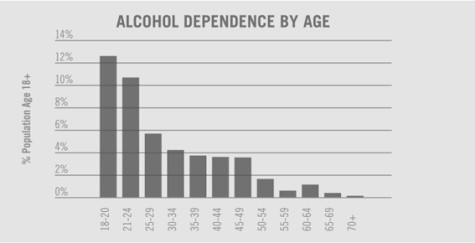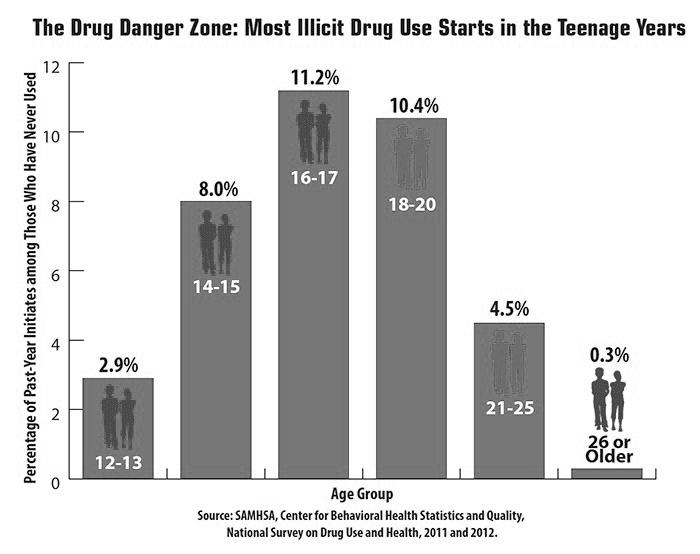Drug Dilemma: Should Students Stand Up or Stamp Out?
Holiday 2015: Innovation and the Mind
Graph depicting when illicit drug use begins.
The majority of people, if not everyone, have seen the effects of drugs and alcohol at some point in their lives. Whether through their family, friends, acquaintances, or even strangers, the effects are everywhere. This does not mean that everyone has seen drastic or horrific changes in the people around them, it simply means that everyone has witnessed what drugs and alcohol can do. Wherever you may fall on this scale, drugs and alcohol impact your life. As we continue through high school, go off on our own in college, and experience the world as adults, we will be given endless opportunities. It is a constantly active decision in our lives to either try drugs and alcohol or not to. Neither decision has to drastically influence one’s life, but having all the information to make these choices is crucial.
In a building bustling with teenagers, the occasional use of drugs and alcohol in the student body is inevitable. Although this does not make it acceptable, it brings up the normalcy of drug use. Hannah Feldmann ’16 says, “I think [using drugs and alcohol] is simply how teenagers are. I think that it’s very normal for teenagers to experiment and be curious about substance use.” This opinion seems to be common with WFS students. The correlation between common perception of teenage drug use and that of the WFS populus seems to differ depending on who one asks.
If drugs and alcohol are illegal and considered to be dangerous, then why do teenagers continue to use them? Some point to media and culture as a leading cause. Others to peer pressure. Drug Prevention Specialist, Brenda Conlan, often referred to by Friends students as the “Drug Lady” comes every year to speak to sophomores about the dangers of drug and alcohol usage. She sees drug usage as a form of social order, “High school students see some of their smart, talented, and nice classmates getting drunk and high on the weekends with no apparent consequences. This all leads to the belief that drugs can be used safely and it’s just a matter of control. But nobody ‘experiments’ long term [with drugs] and eventually you will be faced with the hassle of stopping or having problems.”
Other theories as to why students use drugs and alcohol range from just wanting to have fun and let loose, to attempting to cope with a serious mental illness. There has been extensive research attempting to decipher this phenomenon. Head of Upper School, Rebecca Zug says “Research and the experience at different schools show that there are a variety of reasons that students engage in risky behavior, including using alcohol and drugs. Sometimes, there is an addiction or mental health problem. Sometimes, it’s to feel a sense of power against authority. Sometimes, it’s to fit in with what people around them are doing.”
According to several students at WFS, another major reason for drug and alcohol use is the simple desire to have fun. Feldmann says, “In my opinion, the main reason that students do drugs/alcohol is because it’s fun…I think that no matter what steps are taken, students will always use drugs and/or alcohol. It’s just a matter of being responsible with it. Instead of just telling kids not to drink, they should tell them how to safely drink.” Drug and alcohol professionals explain that there are reasons lying underneath this simple exterior, but it is important to acknowledge why students at least think they are participating in drug and alcohol use.
Conlan looks beyond teenage reasoning for drug use, and considers the safety risks to consumption, “I approach all teen drug use, which includes alcohol, as a health and safety issue. I focus on health and the social and emotional impact substances can have on a young person.” This emotional impact, Conlan says, can disrupt the way that teens view and react towards daily life, “If young people relax or have more fun when they drink, they may have trouble relaxing and having fun without alcohol. If one learns to enjoy life and relationships sober, alcohol abuse is not as appealing or interesting.”
Conlan’s comments correspond with studies conducted by the National Institute on Drug Abuse (NIDA). In one study, it was shown that marijuana interferes with attention, motivation, memory and learning; so much so that regular heavy marijuana use by teens can lead to an IQ drop of up to eight points. The same results were found in relation to alcohol use, according to a study conducted by the Center for Disease Control (CDC). Problems range from school and social issues, to physical issues as a result of a hangover or poor decisions made while drunk, to abuse of other drugs.

Drugs and alcohol have an enormous impact on the brains of young people. A person’s brain does not stop growing until they reach their mid-20’s. During teen years the brain essentially goes into rebellion mode. At this stage, the brain has not yet developed the ability to react with caution, leading to experimentation without thought. According to Psychology of Addictive Behavior, the use of alcohol at a young age, even in small quantities, can influence a child’s memory and attention span. Similarly, the use of marijuana has been known to influence attention span and overall “laziness.” A report from Popular Science states that according to PET scans the dopamine levels found in people who smoke cannabis regularly are significantly lower than those who do not, indicating a lack of energy and motivation found in regular marijuana smokers.
There has been extensive research showing that there is an obvious correlation between alcohol consumption and depression. The question that remains is whether people who are depressed tend to look to alcohol as an escape or whether excessive alcohol consumption can cause depression. Both are true. Research shows that depressed teenagers and children are more likely to resort to alcohol as a means of escape. Alcohol is also a depressant. It is meant to reduce energy and slow a person’s mind. The excessive use of alcohol can cause a person to have both a temporary period of depression or a clinical diagnosis.
Despite the effects of marijuana, according to a Pew Research study, 7 in 10 Americans believe that alcohol is more harmful to a person’s health than marijuana. Whether this popular perception is true or not is hard to say, as conclusive research towards the effects of marijuana is yet to be produced. This is in stark comparison to alcohol, where effects of usage are commonly known and more publicly accepted. According to the CDC, alcohol is responsible for more than 4,300 annual deaths among underage youth.In 2010, approximately 189,000 people under 21 visited the emergency room for treatment as a result of injuries and other conditions relating to the consumption of alcohol. As a result, 11% of all the alcohol consumed in the United States is drank by people aged 12-20. This has drastic effects on health. According to the CDC, youth who start drinking before age 15 are five times more likely to become alcoholics later on in life than those who began drinking after they turned 21.
In a recent survey conducted by (NIDA), in the past year, 27.2% of higher schoolers have used an illicit drug. In the same study, it was found that drug use by American high schoolers has continued to annually decrease in terms of the usage of alcohol, cigarettes, and prescription pain relievers. The one drug whose usage has remained steady, and, in other studies reportedly even increased, was marijuana.
The increase in marijuana usage among high schoolers comes at a time where the drug is legal in states such as Colorado and Washington. It comes at a time where 64.9% of high school seniors believe that occasional smoking of marijuana does not put the user at great risk. It comes at a time where the usage of marijuana has become so normalized for high schoolers, that 81% say that the drug is easy to get. A pattern towards high schoolers’ usage of weed has emerged: as teens begin to see marijuana as less dangerous, it is smoked more often.
Most people use drugs for the first time as teenagers, with a majority of new illicit drug users beginning with marijuana. Because of this, marijuana is the most commonly used drug. According to NIDA, 78% of the 2.4 million people who began using marijuana last year were teenagers. Not surprisingly, drug use is highest among people in their late teens and twenties. Despite common perceptions among high schoolers that marijuana does not greatly affect one’s health, out of all drugs, it has the highest dependence or abuse rates.
Although drug and alcohol use do not have to be life altering or threatening, they often can be. The effects that drugs have on causing mental health issues or worsening already present ones is severe. Drugs can even simply affect the motivation students have to learn and thrive. This ever-present danger brings up the question for students, “Where do I get help?” Many students have friends, family members, or professionals they can discuss their lives with. For those who can not, the school may be their only outlet. An anonymous student says, “I think WFS tries to educate the students as much as possible which both helps and hinders the situation. Making sure people are educated and informed of the dangers of drugs is good, although I think that sometimes the repeated talk of drugs could deter people from openly seeking help about something because they could feel ashamed for being in the situation in the first place.” This situation puts adults in a difficult position to both protect the safety and privacy of the student. When talking about whether or not WFS provides a safe environment for students to talk to faculty about issues regarding drugs and alcohol, an anonymous student says, “I don’t think Friends has the most open environment for communication when it comes to drugs and alcohol. I feel like no one would be upfront if they had a drug problem because of fear of getting kicked out of Friends.”
Drug addiction is a complicated problem, and it is important to remember that people can get addicted to virtually anything. When asked what the most addictive drug is, Conlan’s answer was quite simple, “Whatever drug a person uses is the most dangerous drug to that individual. A drug can’t hurt you unless you’re involved with it. Addiction has more to do with the user than the drug itself.”
If a person becomes addicted to a drug, this drug becomes the most dangerous drug for that person. Some drugs, though, are more harmful than others due to potency and substance. Conlan commented, “Certain drugs have the capacity to cause death by overdose, which clearly makes them more immediately threatening than drugs like marijuana that don’t have those catastrophic effects. Drugs that depress the central nervous system [such as opiates, sedatives, and alcohol] can cause fatal suppression of respiration and should be considered highly dangerous. Alcohol poisoning is a serious condition that can result in death without medical intervention.”
Conlan has advice for teenagers doing drugs, “Let yourself grow up and become your natural, wonderful self. You’re too important to risk addiction or other harm by using substances. All the good people who care about you wish you a safe and joyous life!”




































